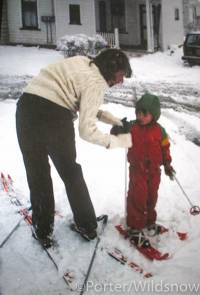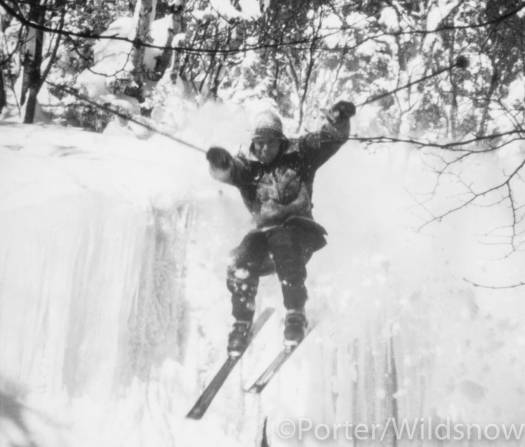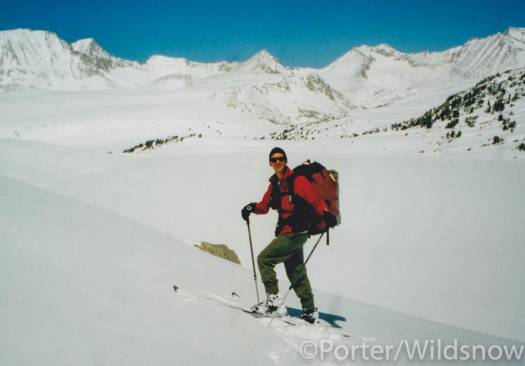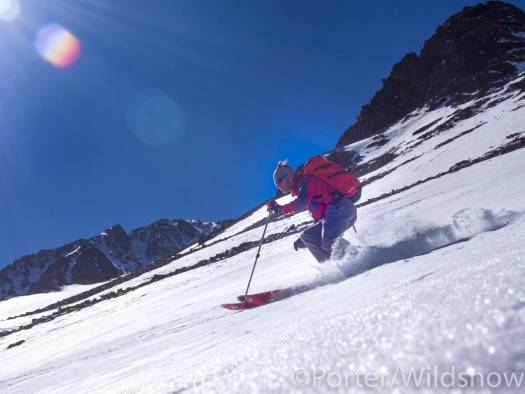Jed Porter
I am not a unique and special snowflake.
One’s path to backcountry competence requires equal parts motivation and regimented, specific growth. We gather around the WildSnow virtual campfire because we share the motivation part. Reader and writer alike want to slide around on untamed frozen water crystals. That is no coincidence or mystery. What is curious, and worth discussing, is the path we each take in our skill-and-judgment acquisition.
“How will I grow into the backcountry traveler that I want to be?”
Let us check out the path, to date, of one particular backcountry practitioner. I know this story well, because it is my story. It is a common plot line. Along the way I hope that each reader can glean some guidance for his or her own path.
Sure, I have performed on skis, in the backcountry, at a high level. I’ve even had my skills assessed and approved in the form of recognized guiding credentials (IFMGA, AMGA). But I’m also just a “regular guy” who buckled down to acquire, and will continue to acquire, skills and judgment in the backcountry.
First, something has to plant the seed on fertile ground. For me, the soil was tilled by my parents who created an atmosphere of athleticism and wilderness appreciation. Neither of them are much more than casual recreationists, but the overall vibe was one of outdoor appreciation. And they got me on skis at least a few times a year until I went to college.
In college things really took off. Through magazines, slideshows, and the web, I discovered the potential of snowy mountain travel.
I also connected with like-minded, barely-more-experienced-than-me, partners. This is a classic phase; perhaps you are there right now. You have enthusiastic friends. One of you occasionally taps into a greater experience and comes back to share, but generally you are all tromping around and learning together. At this vulnerable point, temper that enthusiasm with boundaries.
In my case, on the east coast of the US, we had natural protection because there is just so little avalanche terrain there. We remained dogmatic about skiing steep and open terrain only in late spring. In lieu of avalanches, we exposed ourselves to more immediate risks like crashing into dense timber below frozen creek-bed waterfalls.
I came out of my university days with ski skills, fitness base, and basic backcountry touring acumen. I had taken an avalanche course. I’d skied about only about 4000 feet of avalanche terrain, but I had all the other components in process.
My next phase was far more intentional. Out of college, in 2001, I was stoked on skiing and rock climbing. I did what it took to team up with strong mentors in amazing terrain. I moved to Bishop, California. I knew I would find friends there to simultaneously push and cushion my development. I didn’t know how it would happen, but I was sure that if I put myself there, it would come together.
Indeed, before snow hit the ground my first season in the Sierra, I met Bill Stanley, a super accomplished skier who was just itching to take someone under his wing. That happens! One doesn’t acquire skills and experience without also acquiring an appreciation for the mentorship process. And anyone that has that appreciation is inspired to pass it on. Bill also probably thought he had a young gun to break trail and carry the big pack when he got older.
During my first seasons in the Sierra, Bill showed me around and modeled a disciplined, thoughtful approach to big mountain ski mountaineering. We did huge day tours weekly, and we teamed up for my first (and only, to date) “Trans-Sierra” ski tour.
Without explicitly teaching, he showed the way. He engaged me as a partner in the decision-making process on every level.
We’d start talking about the weekend’s plan on Wednesday. We’d have route and gear choices made by Friday evening. We would start at the right time each day, hit our time estimates on the head, and find the best snow in the range.
Bill was particular about group construction, and choosing the appropriate objective for the team. He knew when to charge and when to turn around at the trailhead. The field “go/no go” choice with Bill was made mainly for emotional or group-dynamics reasons. We never left the car without a solid, well-founded hypothesis about what we would find. Rarely did Bill say, in the mountains, “I don’t think we should do this.” On the contrary; frequently he would climb onto my ski tails and say something to the effect of “get your rear in gear.”
I also skied with others and on my own in this time period. Bill stayed invested in those outings as well, providing feedback on proper progression. Sadly, Bill never got to let me break trail or carry the heavy pack. He died in a car crash in 2004.
Those early seasons in Bishop were the times of my most rapid advancement. The next period was perhaps my most dangerous.
Fit and confident, I had a growing intimacy of my home terrain. I had strong partners and enough of a “resume” to put me in the position of decision-maker, without truly sophisticated skills. Fortunately, the Sierra is a somewhat forgiving playground, and I considered myself a thoughtful, conservative traveler. I eventually wrapped up that sketchy, “in between” phase with the start of my professional guide training in 2007.
Guide certification, and the associated courses and exams, is a rigorous process. The AMGA instructs and examines at a high level. The component skills learned in this process are internationally vetted and proven with decades of experience.
However, it is just a series of discreet, albeit complicated, skills. With rare exceptions, a candidate has little to no contact with instructors outside of a single program. The instructors are astute and concerned, but they simply do not have the contact with candidates that could be considered mentorship.
Mentorship is a holistic, big-picture supervision of one’s growth. It takes years.
The process of earning my IFMGA certification took six years. In that time I worked for two certified guides. I was making them money, they believed in mountain travel and the guiding profession, and they liked what I was doing with my life and aspirations. Neil and Howie were my mentors through that time.
In that period, I was growing, simultaneously, as a guide, skier, climber, and avalanche instructor. My mentor team watched over these roles.
We would regularly discuss progression and experience acquisition. They were available for pre-trip planning for every single outing I took, whether on the clock or not, and for post-event debrief. I spent very little time in the field with either of them. I can count on one hand the times I have skied or climbed for fun with Neil. In the process of earning my IFMGA certification, in six years of working for his company, I never once worked in the field with Howie, except on occasional avalanche courses.
Given the amount of growth I can attribute to their mentorship, very little of what I learned from them was in the field. Field time was like punctuation in this article. In the grand scheme of things there is very little, and without it you’d get the point, but it makes a ton more sense with it.
Now I am involved with numerous initiatives in the outdoor recreation. Whether it is helping gym climbers transition to real rock, facilitating new guides earning certification, or serving the growing masses of aspiring ski mountaineers, a common theme is the need for mentorship.
I believe in mentorship. I am here to put my money where my mouth is. Every year I volunteer at at least one climbing or skiing festival. Every guided trip I do is an opportunity to instruct and model.
Lastly, and this is something I am quite excited about, I offer my own pro bono, email-based mentorship program. Like others have done, and do, for me, I work with individuals on designing their progression, choosing and planning outings, and debriefing those outings.
There are absolutely no strings attached, but realize that I believe that every mountain traveler will gain a great deal from time in the field with a certified mountain guide. This is not in the budget for all, I know, and my recommendations will consider the financial constraints of each person involved. Check out my training and mentorship program, see if we might fit well together, and shoot me an email application as directed on the site.
In the end, whether you work with me or not, trust that there are people out there with whom you can partner to better your skills and judgment in the backcountry. Regardless of the shape your path takes, there is much to be learned from peers and mentors at every single phase of your ski mountaineering development.
(WildSnow guest blogger Jed Porter is a full-time, year-round mountain guide currently on the road quite a bit. Home this winter will be the mellower side of “America’s Steepest Range.” He’ll gladly drive over Teton Pass to ski with you, through Exum Mountain Guides, in Grand Teton National Park.)
Jed Porter is a passionate adventure skier and all-around mountain professional. His primary work is as a mountain guide, skiing and climbing all over the Americas and beyond. Learn more about him at his website linked below.




